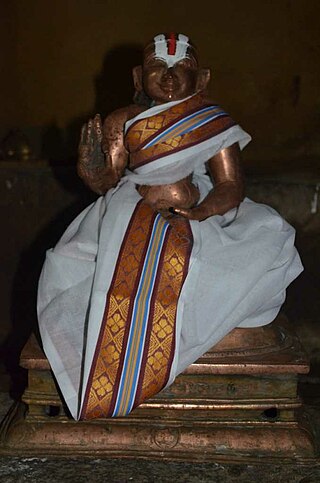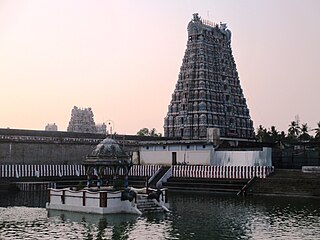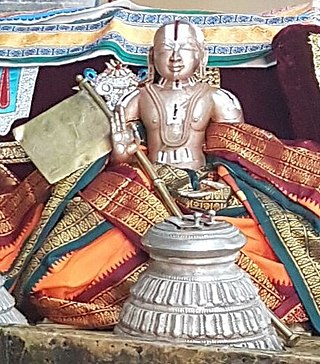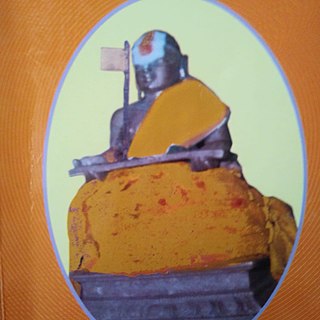Swami Mudaliyandan was a Hindu Vaishnava religious figure who lived in the 11th century CE. [1] He was a nephew of Sri Ramanuja, the codifier of the philosophy of Srivaishnavism.
| Part of a series on |
| Hinduism |
|---|
 |
Swami Mudaliyandan was a Hindu Vaishnava religious figure who lived in the 11th century CE. [1] He was a nephew of Sri Ramanuja, the codifier of the philosophy of Srivaishnavism.
Swami Mudaliyaandaan was born in 1027 CE at Pachhai Vaarana Perumal Sannidhi (referred to as "Nazarethpettai" today) in Thondai mandalam, in the state of Tamil Nadu in South India. His parents were Vaadhoola Kula Thilaka Sri Anantha Narayana Dikshithar and Naachiyaramman (Sri Ramanuja 's sister).[ citation needed ]Daasarathi, as he was named, [2] was Ramanuja's Priya Bhagineya in the parlance of the age. Born to his service, and known as "Yathiraaja Paaduka", he enjoyed a special relationship with Emberummanaar (Ramanuja) all his life.[ citation needed ]
Having begun his learning with his father, Daasarathi would go on to become, with Koorathazhwan, a pillar of support to Emberumaanar, acclaimed by him as being identical to his thridandam - his staff of office as a sanyasi. However, Emberumaanar kept him busy in many ways, as he was a capable executive and administrator. He was later to be known as "Sriranganaatha Divyaalaya Nirvahana Dhurandhara" - the genius who organized, under Emberumanaars tutelage, the administration of the Sri Ranganathaswamy Temple.[ citation needed ]
As he ruled the temple staff like Senai Muthaliyaar (Sri Vishvaksena), he was given the name Muthali-Aandaan.[ citation needed ] He is mentioned in the Koyil Ozhugu, the chronicle of Sri Ranganathaswamy Temple, in glowing terms: "muthaliyaandaanum kurattilirunthu koyil kariyaththaiyum uLLe karuvulaka vaasalileyirunthu thirumeni upachaaraththayum, sannathiyile irunthu thiruppavaLa upchaarangaLayum udayavar niyamanappadi aaraaynthu kondu anaiththazhagum kaNdarula paNNIk-kondirunthaar". (Roughly translated as: And Muthaliyandan administered the following, according to Ramanuja's orders, the many works of the temple, the services to the Lord, and the works of the Shrine.)[ citation needed ]
Sri Muthaliyaandaan is most well known for his lapidary saying, here given in transliterated maNipraavaaLam: "oru malaiyil ninru, oru malaiyil thaavum simha shareeraththil janthukkaL pole bhaashyakaarar samsaaralanganam paNNa avarOdundaana kudalthudakkaale naam udhdheerdaraavuthomenru muthaliyaandaruLi-ch-cheytha paasuram". This is roughly translatable as follows: When a lion leaps from a mountain to another, all the creatures that live on his body go with him. Even so, when Udayavar transcended this world, all of us who are associated with him benefit from this as well.
His descendants are now among the Acharyas of the Sri Vaishnavism tradition, and carry the title of Mudaliyandan Swami. Prominent one being his son, Srimad Vadoola Kovil Kandhadai Annan Swami, whose descendants are one of the ashtadiggajas of the Sri Vaishnava sampradaya following the Thenkalaiacharya branch.

Vishishtadvaita, is a school of Hindu philosophy belonging to the Vedanta tradition. Vedanta refers to the profound interpretation of the Vedas based on Prasthanatrayi. Vishishta Advaita, meaning "non-duality with distinctions", is a non-dualistic philosophy that recognizes Brahman as the supreme reality while also acknowledging its multiplicity. This philosophy can be characterized as a form of qualified monism, attributive monism, or qualified non-dualism. It upholds the belief that all diversity ultimately stems from a fundamental underlying unity.

Ramanuja, also known as Ramanujacharya, was an Indian Hindu philosopher, guru and a social reformer. He is noted to be one of the most important exponents of the Sri Vaishnavism tradition within Hinduism. His philosophical foundations for devotionalism were influential to the Bhakti movement.

Nammalvar was one of the twelve Alvar saints of Tamil Nadu, India, who are known for their affiliation to the Vaishnava tradition of Hinduism. The verses of the Alvars are compiled as the Naalayira Divya Prabandham, where praises are sung of 108 temples that are classified as divine realms, called the Divya Desams. Nammalvar is considered to be the fifth in the line of the twelve Alvars. He is highly regarded as a great mystic of the Vaishnava tradition. He is also considered to be the foremost among the twelve Alvars, and his contributions amount to 1352 among the 4000 stanzas in the Naalayira Divya Prabandam.

Vedanta Desika (1268–1369), also rendered Vedanta Desikan, Swami Vedanta Desika, and Thoopul Nigamantha Desikan, was an Indian polymath who wrote philosophical as well as religious and poetical works in several languages, including Sanskrit, Manipravaḷam, Tamil and Prakrit. He was an Indian philosopher, Sri Vaishnava guru, and one of the most brilliant stalwarts of Sri Vaishnavism in the post-Ramanuja period. He was a Hindu devotee, poet, Master of Acharyas (desikan) and a logician and mathematician. He was the disciple of Kidambi Appullar, also known as Athreya Ramanujachariar, who himself was of a master-disciple lineage that began with Ramanuja. Vedanta Desika is considered to be avatar (incarnation) of the divine bell of Venkateshvara of Tirumala by the Vadakalai sect of Sri Vaishnavism. Vedanta Desika belongs to Vishvamitra/Kaushika gotra.

Vāraṇādrīśa, more commonly referred to as Pillai Lokacharya, was a prominent Sri Vaishnava leader and philosopher who authored several works important to Vishishtadvaita philosophy.

Rupa Goswami was a devotional teacher (guru), poet, and philosopher of the Gaudiya Vaishnava tradition. With his brother Sanatana Goswami, he is considered the most senior of the Six Goswamis of Vrindavan associated with Caitanya Mahaprabhu, a hidden avatar (incarnation) of Krishna in Kali Yuga.

Sanatana Goswami was a principal follower of Chaitanya Mahaprabhu. Sanatana wrote a number of works in the bhakti tradition of Gaudiya Vaishnavism and was the senior most of the influential Six Goswamis of Vrindavan, among whom was his brother Rupa Goswami.

The Ranganathaswamy Temple is a Hindu temple dedicated to Ranganatha, is located in Srirangam, Tiruchirapalli, Tamil Nadu, India. Constructed in the Dravidian architectural style, the temple is glorified by the Tamil poet-saints called the Alvars in their canon, the Naalayira Divya Prabhandam, and has the unique distinction of being the foremost among the 108 Divya Desams dedicated to the god Vishnu.

Kulothunga II was a Chola Emperor from 1133 CE to 1150 CE. He succeeded Vikrama Chola to the throne in 1135 CE. Vikrama Chola made Kulothunga his heir apparent and coregent in 1133 CE, so the inscriptions of Kulothunga II count his reign from 1133 CE. According to historians Nilakanta Sastri and T.N Subramanian, Kulottunga Chola II was not the son of Vikrama Chola and they have suggested that there was a break in the line of succession.

Koil or Koyil or Kovil, is the Tamil term for a distinct style of Hindu temple with Dravidian architecture. Both the terms koyil and kovil are used interchangeably. In Tamil, kōvil is the word derived, according to the rules of Tamil grammar.

Alagiya Manavalan, best known by his epithet Manavala Mamunigallit. 'The great saint, Manavalan' (1370–1450), was a Hindu theologian. He was a major proponent of the Sri Vaishnavism tradition in the 15th century in Tamilakam, disseminating it with the help of his eight disciples. The disciples of Manavalan established places of learning to teach the Vishishtadvaita philosophy in Tamilakam.

Sri Vaishnavism is a denomination within the Vaishnavism tradition of Hinduism. The name refers to goddess Lakshmi, as well as a prefix that means "sacred, revered", and the god Vishnu, who are together revered in this tradition.

Yamunacharya, also known as Alavandar and Yamunaithuraivan, was a Vishistadvaita philosopher based in Srirangam, Tamil Nadu, India. He is best-known for being a preceptor of Ramanuja, one of the leaders of the Sri Vaishnava tradition. He was born in the early 10th century CE, and was the grandson of Nathamuni, a famed yogi, who collected the works of the Tamil Alvars.

The Pundarikakshan Perumal Temple or Thiruvellarai Temple in Thiruvellarai, a village in the outskirts of Tiruchirappalli in the South Indian state of Tamil Nadu, is dedicated to the Hindu god Vishnu. Constructed in the Dravidian style of architecture, the temple is glorified in the Naalayira Divya Prabandham, the early medieval Tamil canon of the Alvar saints from the 6th–9th centuries CE. It is one of the 108 Divya Desams dedicated to Vishnu, who is worshipped as Pundarikakshan and his consort Lakshmi as Pankajavalli.

Nathamuni, also known as Sri Ranganathamuni,, was a Vaishnava theologian who collected and compiled the Naalayira Divya Prabandham.

Eri-Katha Raamar Temple is a Hindu temple dedicated to Rama located in the town of Maduranthakam, Tamil Nadu, India. The temple is glorified by Ramanujar, Thirumalisai Alvar and classified as one of the 108 Abhimana Kshethrams of the Vaishnavate tradition. This is the sthalam (place) where Udayavar was named Ramanuja. The temple is also known by other names such as - Mathuranthaka Chaturvedi Mangalam, Vaikunda Varthanam, Thirumathurai, Thirumanthira Tirupathi, Karunagara Vilagam. Thirumalisai Alvar attained siddhi (enlightenment) in this sthalam (place). Also, Sri Ramanujar was instructed the Pancha Samskara Mantram at this place.
Parasara Bhattar, also called Periya Bhattar and Parashara Bhattarya, was a follower of Ramanuja, a 12th-century Sri Vaishnava teacher. He was the son of Koorathalvar. His works include the Srirangarajastavam. He wrote a commentary in Sanskrit on Vishnu Sahasranamam from a Sri Vaishnava viewpoint, titled Bhagavadguna Dharpanam, in contrast to the Advaita view of Adi Shankara.

Ranganathaswamy temple in Karamadai, a town panchayat in Coimbatore district in the South Indian state of Tamil Nadu, is dedicated to the Hindu god Vishnu. It is located 23 km from Coimbatore in the Coimbatore–Mettuplayam highway. Constructed in the Dravidian style of architecture, the temple is dedicated to Vishnu, who is worshipped as Ranganathaswamy and his consort Lakshmi as Ranganayaki in this temple. It is considered one among the 108 Abhimana Kshethram of Vaishnavate tradition.

Ayee Jananyacharya or Devaraja Perumal was a Hindu Sri Vaishnava religious leader, great saint, and one of the important propagator of the Sri Vaishnavism tradition. Sri Jananyacharya Swami was Seventh in the lineage of Sri Ramanujacharya. He was a scholar in ubhaya vedanta who took Vishishtadvaita school of vedanta to the next level and widely popularized and propagated the Sri Vaishnava tradition.

The Amalanatipiran is a work of Tamil Hindu literature written by Tiruppan Alvar, comprising ten hymns called pasurams. The title of this work is a reference to the unblemished and flawless nature of Vishnu. The work is part of the compendium of the hymns of the Alvars, known as the Nalayira Divya Prabandham.